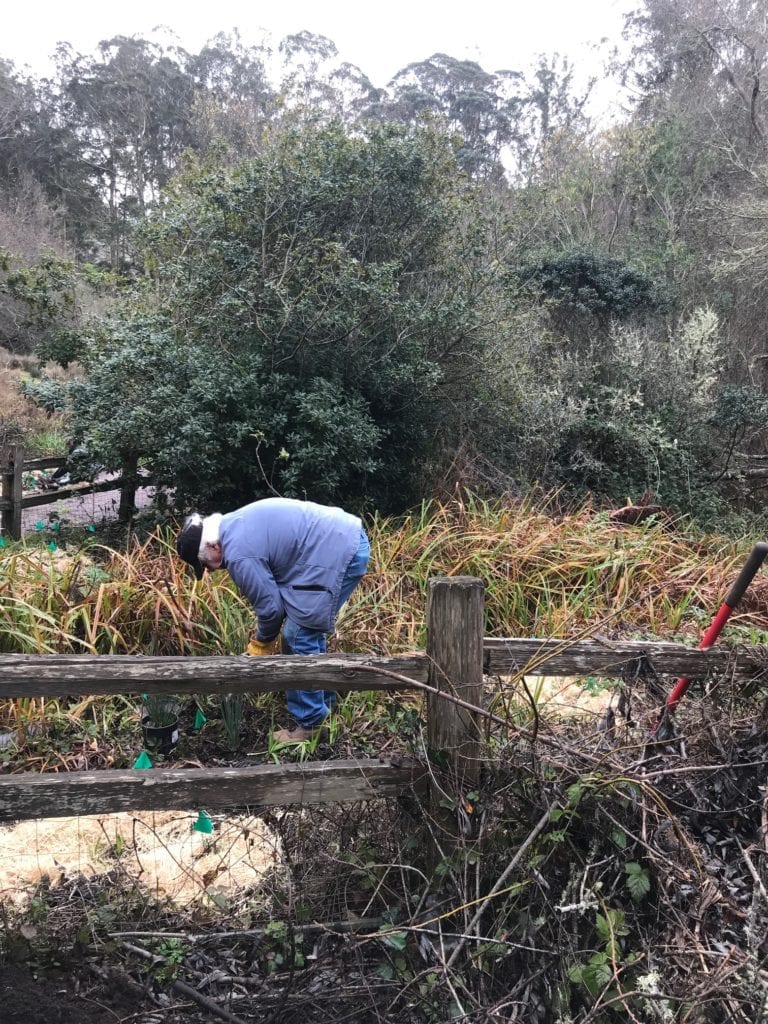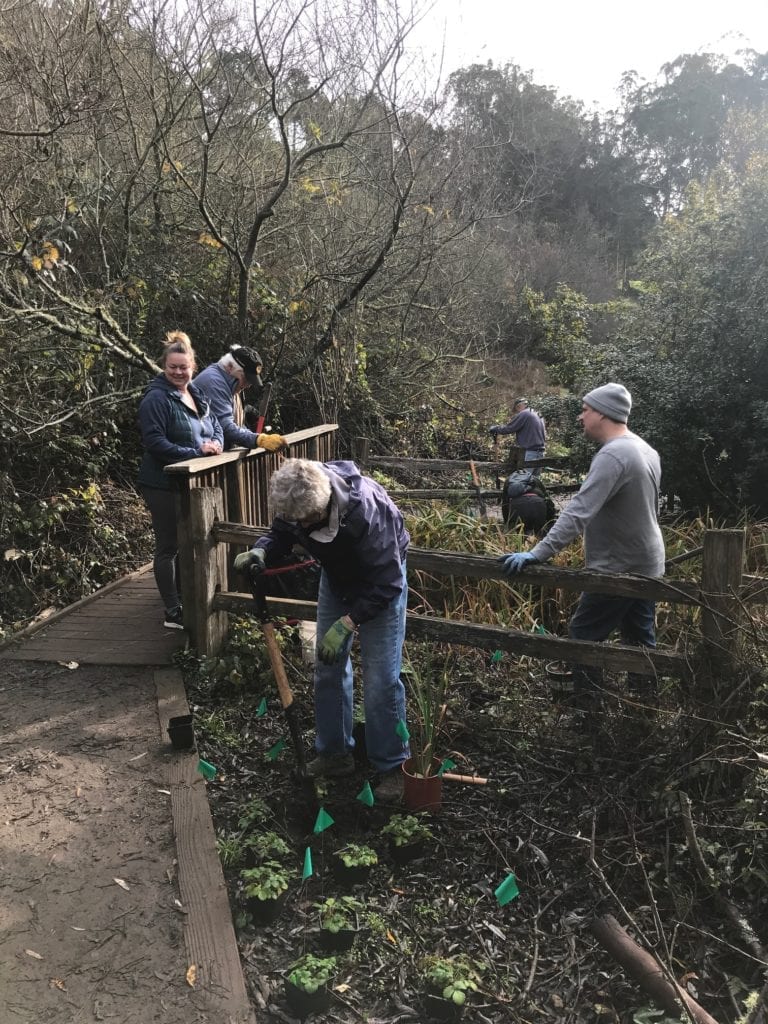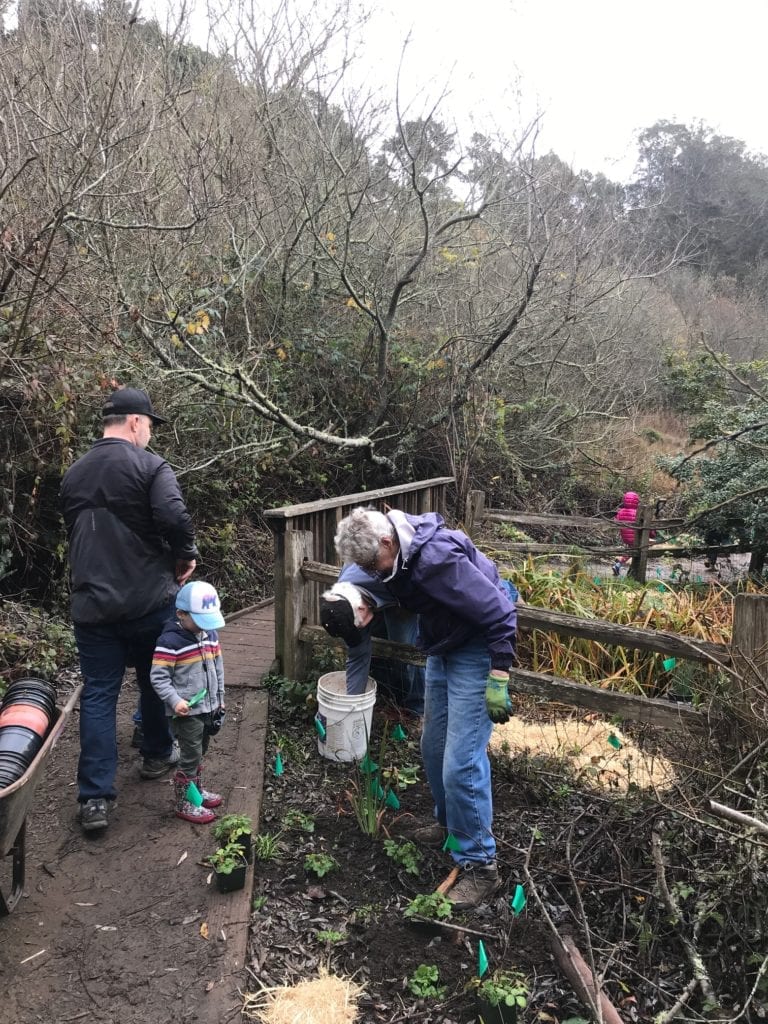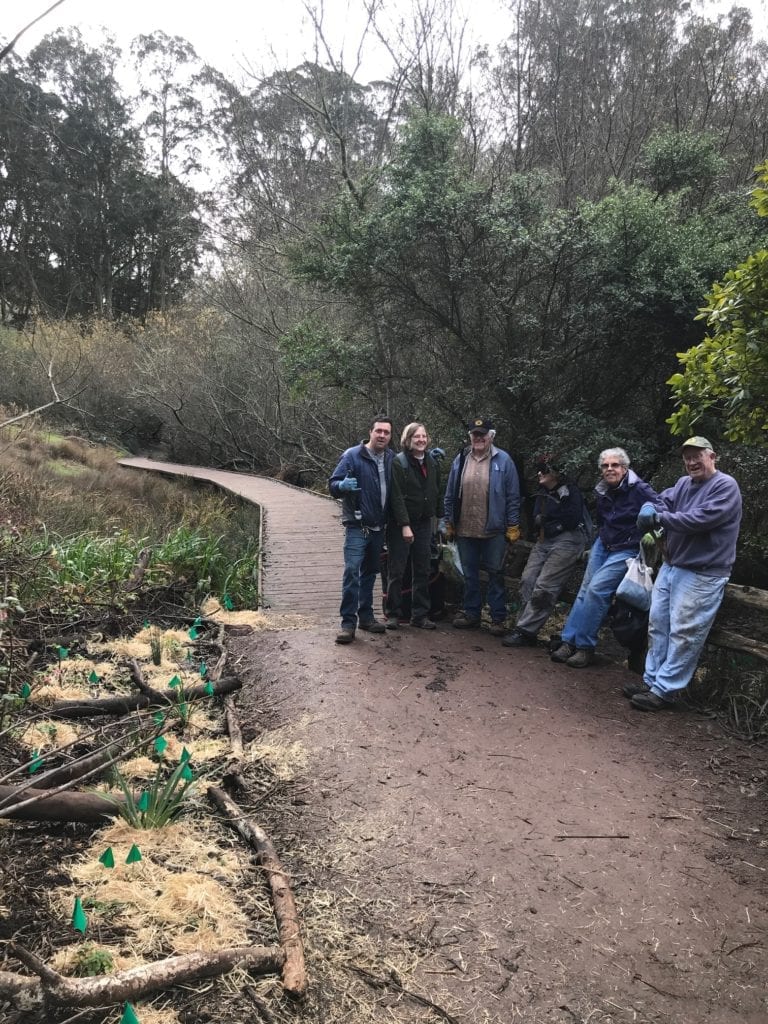
On January 8, five members of Friends of Glen Canyon Park worked in Glen Canyon planting varieties of California native plants. Supervised by Dylan Hayes, a Recreation and Park’s Natural Resource Division natural resource specialist, the volunteers placed woodland strawberry, Douglas iris and pink flowering currant on either side of a split rail fence bordering Islais Creek.
Dog walkers, joggers and an uptick of hikers, who’d only recently discovered Glen Canyon when traversing the well-publicized Crosstown Trail, were greeted by Hayes’ New Year’s salutations.
“Happy San Francisco,” Hayes repeated as passers-by weaved among volunteers on a narrow path in the 70-acre sylvan space, one of 32 natural areas NRD manages.
On one side of the split rail fence volunteer Sam Orr leaned over a bucket of water babies and cupped a handful of the wet goblets. Water babies are marble-sized globes of water-soaked polymer. In the soil they slowly release their water, hydrating the fledgling plants and then biodegrading.
Orr deposited them in a hole he’d dug only moments earlier, then backfilled soil next to the strawberry. He fashioned a berm, which would facilitate further irrigation since rain was forecast the next day. Then he patted straw around the circumference of the plant. He repeated his labors a half dozen times, then retreated farther into the expanse that NRD dubs Pool 2. There he rested, obscured among a cloister of low hanging. horizontal Arroyo willow.
Orr will never see 79 again.

NRD’s mission is to work with volunteers such as Orr, who bicycled from his home on Noe Street, to manage, restore, enhance and maintain biodiversity in San Francisco’s remnant natural areas. Community volunteers are involved in all aspects of restoration from weeding, erosion control and planting.
Pool 2 is one of three protected restoration areas bookending Islais Creek that NRD stewards. Islais Creek is one of only two surviving San Francisco above ground creeks. That morning over 60 plants, which had been propagated in beds at the RPD’s Golden Gate Park nursery near the park’s bocce ball courts, were strategically positioned. Seeds from existing canyon plants had earlier been harvested by previous Friend’s work parties, then brought to the nursery and nurtured for the day’s efforts.
“It’s what we call a riparian planting,” said Hayes, who is a trained interpretative park ranger and naturalist. “It’s a happy village planting.”
Villagers certainly describe the quintet of volunteers who reside along Chenery, Laidley, Stillings and Sussex byways and have been meeting each Wednesday for a dozen years.
Jean Conner lives on Sussex Street. She arrived for the morning work party after a hiatus of several months due to a broken wrist. Conner’s a charter member of the Friends, as well as an accomplished artist of national repute. Her collages have been displayed in renowned museums and galleries here and as far away as Manhattan.
Mindful of her wrist, she challenged a fence rail after depositing several plants. She’d rolled her hands over each plant’s plastic pot, then removed the loosened offering, teased its roots, splashed water babies into the hole she’d dug, backfilled the hole, then finished up in the same manner Sam Orr had, fashioning a berm and anointing the rim of the hole with smoothed straw.
Like Orr, Conner has passed the three-quarter century mark.
Kay Westerberg and Mary Huizinga are both a few years younger than Orr and Conner. They worked on the east side of the fence, performing similar tasks. The clock now stretched toward 11 a.m. A troop of Glenridge school children trailed a teacher and inched toward Orr, who, after his respite, again reached into a white bucket of water babies and extracted a yogurt cup-full of its wet content.

A boy no more than five studied Orr’s manual hydraulics. Orr has about 75 years on the lad. With one hand the young naturalist held a magnifying glass, with the other a pair of binoculars. His sported rain boots. Above him, sheltered among lichen-crusted willow limbs, a Ruby Crown kinglet harmonized. Farther along the canyon a squadron of song sparrows either played tag in the throes of a mating ritual or circled in some sort of combat maneuver.
Behind Orr and the young Humboldt, Hayes continued waxing ecological.
“We’re planting woodland strawberry today,” he explained, the boy and the dog walker within earshot. Hayes, who has worked with NRD since 2005, has recently been nominated for a Neighborhood Empowerment Award for being a “most empowering city employee” and will accept his award from Mayor London Breed at City Hall on January 29.
“This work is good for erosion control,” Hayes continued. The boy listened; the dog walker nodded.
Snacks awaited him at school; milk bones awaited the pooch at home.
Water and cookies awaited the volunteers, as well. stored inside a Rec and Park flatbed.
The volunteers, now surrounded by a flotilla of green flags noting their two-and-a-half hour labors, retrieved their backpacks and jackets and made ready to depart.
Jim Hanratty gathered his tools, who like his cohorts isn’t aged out. The group, now surrounded by a flotilla of green flags noting their two-and-a-half hour labors, retrieved their backpacks and jackets and made ready to depart.
One task remained.
Hayes wanted to clear encroaching invasive Cape ivy from the germinating plants. Huzinga and Westerberg bent knees. Hayes dragged several willow boughs across the path’s shoulder, now devoid of colonizing ivy. He hoped the woodsy barricade would thwart unleased dogs from playing havoc with the new plants.
Earlier, Hayes had wheel barreled shovels and tools, a bucket of straw and a bucket of water babies to the worksite. Returning now, he pushed the wheel barrel over a wooden boardwalk. To his left stood a seep, home to NRD managed sage, coyote bush, yellow-eyed grass and willow that weeps ornate orbs each October in time for Halloween.
Ahead Glenridge nursery school stood, girdled by stands of redwoods and eucalyptus. To his right, past more willow and thickets of ivy and poison oak, Islais Creek ran, its water shining bright and brown.
